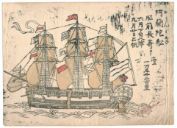The Three-Wave Problem
Looking at the tsuba’s wave pattern beneath the ship can tell us something about its story. In fact, the way in which the waves are pictured seems to be quite specific as they flow into each other, thereby creating foam at the top. This is depicted in sets of three.
A very similar pattern is found on a sword made in Tonkin, a region of Northern Vietnam, in the 17th century. The Dutch were in fact present as traders in this area: that could explain the link between the two objects. Peter Dekker hypothesizes that the tsuba could have actually been commissioned by the Dutch to craftsmen in Vietnam, and then imported by the Dutch into Japan, where they were presented as gifts to the Japanese. This would befit the custom of Dutch-Japanese trade relations, where the Dutch provided gifts to the Japanese prior to trading.
However, this is not the only thinking that stands. If we look at examples of Nagasaki-e once again, we find that waves are represented in a variety of ways. In Fig. 1 the waves are represented in a similar manner, with their bodies flowing into each other and smaller foam curls at the top, often in sets of three. This style of illustrating the wash of the waves in Nagasaki-e seems to coincide with the phenomenon of Japanese artists reinterpreting their depiction of waves, including the wash of the waves, which were inspired by Dutch seascapes and hung in Dutch rooms in Deshima. As we have seen previously, Nagasaki-e and this tsuba share many details in their depiction of Dutch ships, so it is possible to think that the representation of the waves matches a Japanese trend of the time.[Van Gulik 1999]
Given the state of the research on this tsuba at the moment, it is fair to say that both interpretations of the wash of the waves are acceptable. While they tell two different stories about the origin of the object, they seem to both underline the impact that Dutch trade had on Japanese art, and the way in which no craft and no craftsman exists in isolation.
